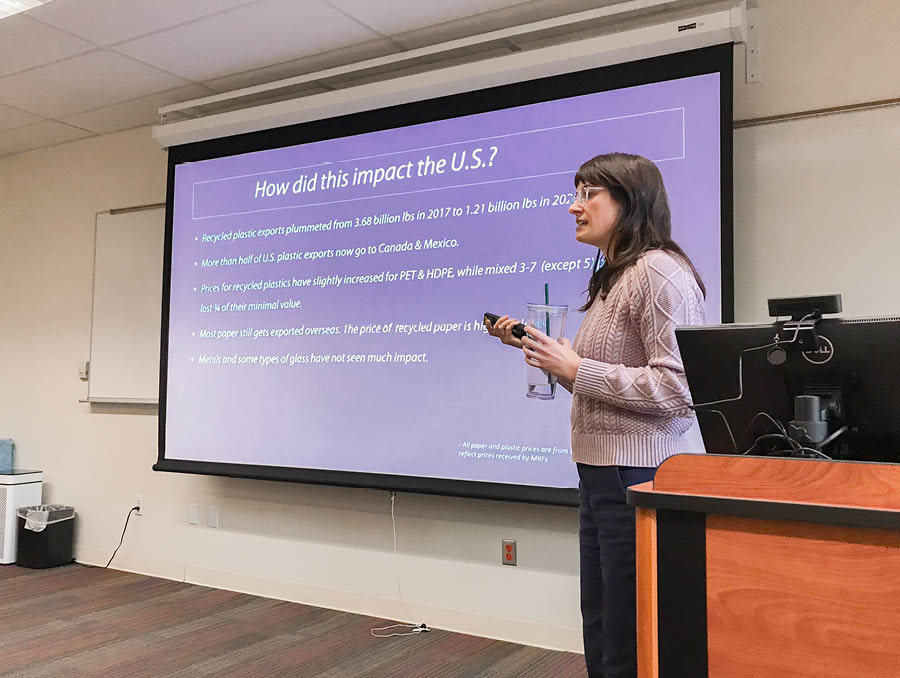Recycling, a commonplace practice for many who wish to create less waste, still remains a mystery to most who participate in the habit. Phoebe Judge, the University of Nevada, Reno’s new Sustainability Manger, however, is no stranger to it – with experience working as the Recycling Coordinator at Waste Management in Reno, Nevada, her knowledge and expertise on the topic prove that there is more to recycling than meets the eye.
How does recycling really work, and what are some common misconceptions that people have about the practice?
At its core, recycling in theory prevents useful and valuable materials from entering the landfill where they can’t be recovered (or where we don’t want to recover them) and instead, puts that valuable material back into the supply chain to supplement the demand on raw (mined or harvested) resources. The reality of recycling, like everything else in life, is less perfect. It still requires energy and fuel to ship those materials to various processors and it’s an energy intensive task to sort through hundreds of tons of material every day (with all that, it’s still much better than landfilling those materials). The success of recycling is dependent on an end market existing. Choosing products that contain recycled content is just as important as sending materials to be recycled.
After China stopped accepting most recycling from the U.S. in 2018, I’ve noticed many people no longer believe recycling is worth the effort. Since 2018, many improvements and commitments have been made to ensure we recover valuable materials. It’s about progress not perfection, and China’s new policy is forcing the U.S. to progress. It’s important to question the process and demand transparency, but recycling is still an important step toward sustainability.
What’s your recycling practice, and what are the most common mistakes you see people make when recycling?
I stick with a few simple rules. First, I don’t bag any recycling or include plastic film (I reuse plastic bags, or I bring them to Sprouts to recycle). Second, I only include cardboard (broken down), paper (such as junk mail), glass and plastic bottles, and metal cans. And finally, I don’t clean them perfectly, but I make sure everything is empty, dry and free of food debris.
When I’m not sure where to take something to be thrown away or recycled, I go to the Keep Truckee Meadows Beautiful website to check their detailed guide and list of companies that accept various materials. I never put electronics, propane cans, tire chains or other wild “one off” type things in any waste bin. They can damage equipment, cause fires, and pose a threat to workers.
I’d say the most common mistake most people make is “feel good” recycling or “wish” cycling. It might feel better to throw everything in the recycle bin instead of the trash, but that habit is detrimental to the recycling stream. Only recycle cardboard, paper, glass and plastic bottles, and metal cans. If you want to feel better about the environment, focus on reduce, reuse, repair, refuse. Avoid single use items if possible, even if they can be recycled.
How does recycling vary from state to state, country to country?
Most recycling programs are very similar, with slight variations. It’s important to look to your local recycling hauler, municipality, or recycling non-profit for guidance. Generally, all recycling programs accept metal cans, plastic bottles, paper and cardboard. Certain areas allow bagged recycling, but that’s not the case here. Some programs accept glass, others don’t. Some programs pay you to deposit materials yourself, and some states have made recycling mandatory. A great resource to know what you can recycle in Washoe County is on the Keep Truckee Meadows Beautiful website.
What is your background in waste management, and what is your current role at the University of Nevada, Reno?
Prior to accepting my position at the University, I worked for Waste Management as a Recycling Coordinator. That role required me to educate the general public, companies, and students on good recycling habits and our local process. I also provided tours of Lockwood Landfill and Reno’s Material Recovery Facility. I find our waste and recycling streams fascinating and I love sharing my knowledge with others. Now as the Sustainability Manager at the University, I work in Planning & Construction within Facilities Services. The Sustainability Manager role covers a broad spectrum, but my primary focus is to decrease campus greenhouse gas emissions. By decreasing material sent to the landfill, we reduce the production of methane, which is a greenhouse gas and contributes greatly to a warming climate.















